Cedar Point – Sandusky, Ohio
Sometimes you encounter a work so monumental that the only appropriate follow-up on behalf of its creator is to never produce anything within that medium ever again, even if they might remain active in other fields. Harper Lee famously only ever published To Kill A Mockingbird, although she continued to be an active presence in the literary world. David Lynch quit moviemaking after 2006’s ambitious Inland Empire, even though he continued to produce work in a variety of different media. The musician known as Captain Beefheart changed the face of American rock-and-roll with his uncompromising music until 1982, when he declared he was “too good at the horn” and permanently retired to pursue painting. Perhaps my favorite of these stories: the philosopher Ludwig Wittgenstein published the Tractatus Logico-Philosophicus in 1921, upon which he declared all of philosophy was solved and spent the next twenty-five years teaching school children in rural Austria and obsessively building a house.1
With Steel Vengeance, I can only hope that the IBox conversion technology will be declared by Fred Grubb and Alan Schilke to have reached its apogee, and that Rocky Mountain Construction will voluntarily suppress their own patent so that they nor anyone else can never convert another wooden coaster to steel ever again. They can continue to build new coasters and a successful business with all-new Topper Track, Raptor Track, T-Rex Track, and whatever other designs come next. But from now until eternity, future IBox conversions can only be a disappointment in comparison, so it’s better that they quit while they’re ahead.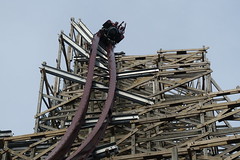
IBox track is an unusual invention in that it’s dependent on a very finite resource pool (i.e. pre-existing wooden coasters) that’s steadily dwindling in both number and quality, and thus the brighter this innovation burns the more quickly it will be exhausted.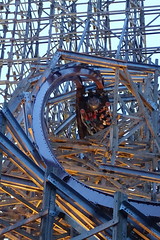 This is why I feel I can say with some confidence that even if there are some other very good RMC conversions in the future, I’m doubtful they can 100% eclipse the scale and ambition of Steel Vengeance, for the simple reason that there are no other remaining wooden coasters that offered as grand of a canvas for RMC to work their magic on as the former Mean Streak provided.2 It took seven years of waiting since New Texas Giant for what every coaster fan in the country knew would be RMC’s golden opportunity to build their biggest and most stunning creation possible, and when the details were revealed and the first riders came back, it did not disappoint. Yet if there’s anything about Steel Vengeance that prevents future IBox conversions from being built, it’s not going to be fear that its perfection cannot be eclipsed; it’s fear that its mishaps will be eclipsed, be it trains bumping, flying cellphones or hot sauce, or stuff falling off that’s… not supposed to.
This is why I feel I can say with some confidence that even if there are some other very good RMC conversions in the future, I’m doubtful they can 100% eclipse the scale and ambition of Steel Vengeance, for the simple reason that there are no other remaining wooden coasters that offered as grand of a canvas for RMC to work their magic on as the former Mean Streak provided.2 It took seven years of waiting since New Texas Giant for what every coaster fan in the country knew would be RMC’s golden opportunity to build their biggest and most stunning creation possible, and when the details were revealed and the first riders came back, it did not disappoint. Yet if there’s anything about Steel Vengeance that prevents future IBox conversions from being built, it’s not going to be fear that its perfection cannot be eclipsed; it’s fear that its mishaps will be eclipsed, be it trains bumping, flying cellphones or hot sauce, or stuff falling off that’s… not supposed to.
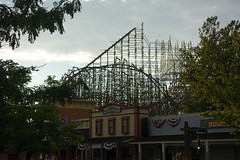 It’s also not purely out of the romantic notion of the unsurpassable masterwork that I make this wish. Unquestionably, Rocky Mountain Construction has posed what is possibly the single greatest philosophical challenge to coaster preservationists. Is it okay to replace a mediocre aging roller coaster with a new one that’s absolutely top-of-its-class? What makes this challenge so vexing is that for their first ten conversions the response was unequivocally unanimous (including yours truly): Yes!
It’s also not purely out of the romantic notion of the unsurpassable masterwork that I make this wish. Unquestionably, Rocky Mountain Construction has posed what is possibly the single greatest philosophical challenge to coaster preservationists. Is it okay to replace a mediocre aging roller coaster with a new one that’s absolutely top-of-its-class? What makes this challenge so vexing is that for their first ten conversions the response was unequivocally unanimous (including yours truly): Yes!
I won’t try to use my old contrarian schtick to argue otherwise: every single IBox steel coaster is better than the wooden coaster that it replaced. That was certainly the case with their earliest efforts, all lumbering wooden dinosaurs that had long since been bastardized to the point that whatever there may have once been to like about them had fallen into a black hole with no possibility of return, and on the day they were decommissioned the only thing
their earliest efforts, all lumbering wooden dinosaurs that had long since been bastardized to the point that whatever there may have once been to like about them had fallen into a black hole with no possibility of return, and on the day they were decommissioned the only thing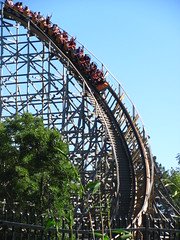 the coaster was good at was shaking loose synapses apart. That was even likely the case in some of the more recent conversions, such as Six Flags Discovery Kingdom’s Roar-into-The Joker or Six Flags Over Georgia’s Georgia Cyclone-into-Twisted Cyclone—both were still good wood coasters, both lost a big element of what made them good in the process, and both still more than made up for it with a dash of RMC’s gravity-warping gee-wizardry. And it was absolutely the case with Mean Streak-into-Steel Vengeance, turning what was once one of Cedar Point’s most universally despised coasters into one of its most beloved, capturing many enthusiast’s new #1 spot and transforming the long march to the farthest tip of the Cedar Point peninsula from a desolate wasteland into a thrill seeker’s Promised Land.
the coaster was good at was shaking loose synapses apart. That was even likely the case in some of the more recent conversions, such as Six Flags Discovery Kingdom’s Roar-into-The Joker or Six Flags Over Georgia’s Georgia Cyclone-into-Twisted Cyclone—both were still good wood coasters, both lost a big element of what made them good in the process, and both still more than made up for it with a dash of RMC’s gravity-warping gee-wizardry. And it was absolutely the case with Mean Streak-into-Steel Vengeance, turning what was once one of Cedar Point’s most universally despised coasters into one of its most beloved, capturing many enthusiast’s new #1 spot and transforming the long march to the farthest tip of the Cedar Point peninsula from a desolate wasteland into a thrill seeker’s Promised Land.
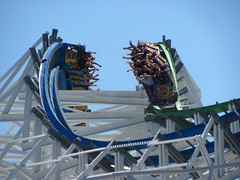 This trend is likely to hold into the future. Rocky Mountain Construction consistently makes really good coasters. Barring any truly misguided attempt to “RMC The Beast” or “RMC The Voyage” as some fanbros have suggested, most future IBox conversions will also probably be better than the wooden coaster that it replaces. Follow this logic all the way and the conclusion is obviously catastrophic for the continuation of older wooden coasters, especially when it starts affecting otherwise fine wooden coasters that would have had long lifespans in their original form if not for an overzealous park operator looking to cash in on the hot new trend.
This trend is likely to hold into the future. Rocky Mountain Construction consistently makes really good coasters. Barring any truly misguided attempt to “RMC The Beast” or “RMC The Voyage” as some fanbros have suggested, most future IBox conversions will also probably be better than the wooden coaster that it replaces. Follow this logic all the way and the conclusion is obviously catastrophic for the continuation of older wooden coasters, especially when it starts affecting otherwise fine wooden coasters that would have had long lifespans in their original form if not for an overzealous park operator looking to cash in on the hot new trend.
The challenge of preservation in theme and amusement parks, as it is with architecture and other large-scale physical works,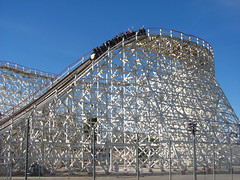 is that space and materials are scarce, finite resources. Unlike traditional artistic media where the question of preserving one piece is unrelated to the question of whether to make another, theme parks only have so many canvases to paint on, and it’s getting to the point where creating something new means painting over something old. A healthy attitude about preservation in this case isn’t to encase everything in resin, but to discuss priorities and consider sustainable alternatives to removal. In this case, it could even be argued that RMC offers a valuable product for creative preservation, retaining the spirit of an older attraction that might have otherwise been slated for demolition (or, perhaps worse, loathing and obscurity) while reviving its relevance for an entirely new generation.
is that space and materials are scarce, finite resources. Unlike traditional artistic media where the question of preserving one piece is unrelated to the question of whether to make another, theme parks only have so many canvases to paint on, and it’s getting to the point where creating something new means painting over something old. A healthy attitude about preservation in this case isn’t to encase everything in resin, but to discuss priorities and consider sustainable alternatives to removal. In this case, it could even be argued that RMC offers a valuable product for creative preservation, retaining the spirit of an older attraction that might have otherwise been slated for demolition (or, perhaps worse, loathing and obscurity) while reviving its relevance for an entirely new generation.
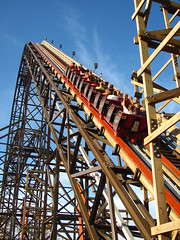 And RMC’s contributions will undoubtedly have a more valuable role in the future development of roller coasters than nearly any of the designs their coasters have replaced; contributions that probably never would have grown to what they are today if the Texas Giant had been deemed too important to touch. Looking at the facts of economics and real estate, I don’t believe any of the IBox conversion coasters would, in an alternate universe, exist today as an all-new creation within the same park alongside the wooden coaster they did indeed replace. (In fact, we arguably did get that once, in 2014 when Six Flags Great America chose to build Goliath as an all-new coaster on the vacant Iron Wolf plot instead of an IBox replacement for American Eagle or Viper.) Even in a strong economy, extremely few parks would build a coaster on the scale of Steel Vengeance if it was an all-new coaster. How can anyone be for the preservation of something mediocre if it prevents the creation of something truly excellent? It obviously would be considered an even greater loss if an RMC creation were to be torn out and converted back into the original wooden coaster profile it replaced, so what’s the moral difference if you make the argument against conversion before it happens?
And RMC’s contributions will undoubtedly have a more valuable role in the future development of roller coasters than nearly any of the designs their coasters have replaced; contributions that probably never would have grown to what they are today if the Texas Giant had been deemed too important to touch. Looking at the facts of economics and real estate, I don’t believe any of the IBox conversion coasters would, in an alternate universe, exist today as an all-new creation within the same park alongside the wooden coaster they did indeed replace. (In fact, we arguably did get that once, in 2014 when Six Flags Great America chose to build Goliath as an all-new coaster on the vacant Iron Wolf plot instead of an IBox replacement for American Eagle or Viper.) Even in a strong economy, extremely few parks would build a coaster on the scale of Steel Vengeance if it was an all-new coaster. How can anyone be for the preservation of something mediocre if it prevents the creation of something truly excellent? It obviously would be considered an even greater loss if an RMC creation were to be torn out and converted back into the original wooden coaster profile it replaced, so what’s the moral difference if you make the argument against conversion before it happens?
Here’s a thought experiment: Imagine if sometime in the late 90’s that Custom Coasters, Intl. offered a service for parks with aging coasters to completely reprofile and reimagine them, replacing slow elevated turns with CCI’s dynamic, lateral-filled swoop turns, and redesigning drops and hills to get CCI’s trademark whiplash ejector airtime, features that coaster enthusiasts of the time all drooled over. CCI would also include modern new rolling stock provided by their German partners at Gerstlauer. This service catches on like wildfire, and quickly many parks with older wooden coasters and no space or cash for an all-new coaster contract CCI to update their rides. They convince Premier Parks, new owners of the Great Escape, to give the recently reopened yet still “old” looking Comet a more modern image as the Silver Comet; the tired and creaking 40-year-old Coaster at the landlocked PNE Playland gets a dynamic new profile and seaside theme as the Great White; and CCI saves Knoebels the cost of building a new wooden coaster in 1999 by rebuilding the Phoenix into another homage to a classic defunct coaster: the Mega Zeph!3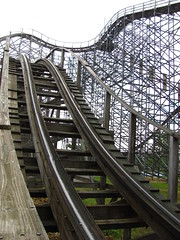
…And, twenty years later, now we’re all stuck with a bunch of middling, forgettable, mid-period CCI coasters in place of where there used to be a diverse array of quirky historical oddities that could have gone on to find newer and larger fanbases in later decades. Obviously this scenario is a bit ridiculous, but the point is that what’s considered “popular”, “outdated”, and “historic” changes with time. Just like CCI coasters were once in favor with parks and enthusiasts who celebrated each new installation before that company ended up in the dustbin of history, it’s entirely within the realm of reason that in a decade or two today’s IBox conversion craze might be regarded as “just another one of those 2010’s fads”, albeit a fad that also took out a handful of what would have become rare and historic wooden coasters along with it during its brief meteoric rise. Some of these “fad” coasters may stand the test of time like Boulder Dash or (in all likelihood) Steel Vengeance, while others might retain all the reverence of Cheetah at Wild Adventures.4
 On the flip side, one of the reasons we lost so many of the greatest historic coasters over the past century is because these landmark rides were only old enough to be considered “outdated” at the time of their removal, with 20 to 40 years seeming to be the typical danger zone no matter when in the timeline you are. Most of today’s enthusiasts don’t like the Dinn Corp wood coasters that typified the 80’s and 90’s, and are glad when the next one is announced to receive an IBox conversion. But what will happen when that “next one” is also the very last one? The 1980’s only have fifteen wooden coasters remaining; the 1970’s are down to ten; the 60’s are at five. Is it inconceivable that in the not-so-distant future we might erase an entire decade of wood coaster history?
On the flip side, one of the reasons we lost so many of the greatest historic coasters over the past century is because these landmark rides were only old enough to be considered “outdated” at the time of their removal, with 20 to 40 years seeming to be the typical danger zone no matter when in the timeline you are. Most of today’s enthusiasts don’t like the Dinn Corp wood coasters that typified the 80’s and 90’s, and are glad when the next one is announced to receive an IBox conversion. But what will happen when that “next one” is also the very last one? The 1980’s only have fifteen wooden coasters remaining; the 1970’s are down to ten; the 60’s are at five. Is it inconceivable that in the not-so-distant future we might erase an entire decade of wood coaster history?
I think Steel Vengeance represents the inflection point of this movement, closing the circle of design evolution that started seven years prior with the redesign of Mean Streak’s sister coaster in Texas. Really good coasters are one thing that enthusiasts and operators should value, but diversity of design is an often underappreciated, and possibly more important value as well. RMC now has fifteen roller coasters in North America alone. Another IBox conversion will probably be of marginal value, especially considering it isn’t going to be another Steel Vengeance, and Rocky Mountain will presumably continue to build innovative, world-class, new-build coasters in the vein of Lightning Rod or RailBlazer. By contrast, many of the oft-cited candidates for future IBox conversions are in one way special or endangered. Whether they’re one of CCI’s largest coasters, an early GCI effort before their “modern” house style had been completely refined, one of Bill Cobb’s more unconventional 1980’s designs, or even a mediocre yet increasingly rare Dinn or Summers creation, they represent a unique chapter in coaster history that, once closed, can’t be reopened.
All that said, Mean Streak was a shit coaster. 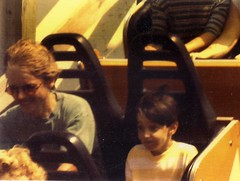
Mean Streak was my first “mega” coaster I’d ever experience, along with my all-time favorite coaster Magnum, when I was all of seven years old. Eighteen years later it was the first coaster I’d ever ride together with my future wife…5 and despite that history I still feel very little sentimentality towards the ride. It wasn’t even that it was rough; a couple of retracking efforts in its later years actually did seem kind of successful. It’s that it was a complete waste of potential energy, sleepwalking through 5,400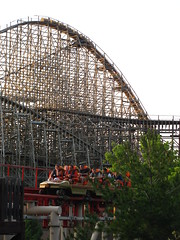 feet of track in search of an interesting or exciting moment that never arrives. Even in its prime Mean Streak paled
feet of track in search of an interesting or exciting moment that never arrives. Even in its prime Mean Streak paled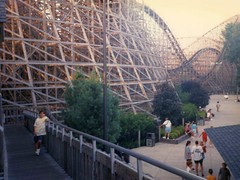 in comparison to its direct predecessor, the Texas Giant, which took home the number one prize during the first two Golden Ticket Awards in ‘98 and ‘99, while those years Mean Streak could barely crack the top 20 despite being the world’s largest wooden coaster at the time.6
in comparison to its direct predecessor, the Texas Giant, which took home the number one prize during the first two Golden Ticket Awards in ‘98 and ‘99, while those years Mean Streak could barely crack the top 20 despite being the world’s largest wooden coaster at the time.6
If there’s only one thing I miss, it’s that Mean Streak was more photogenic than Steel Vengeance. The shape and balance
Vengeance. The shape and balance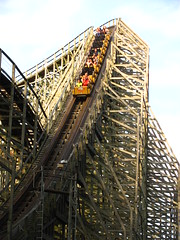 of curves that define an aesthetically pleasing “roller coaster ideal” when viewed from afar are sadly at odds with most contemporary ideals of what makes a thrilling, crowd-pleasing ride experience. The super-steep hills of Steel Vengeance have a precarious and off-balance appearance, the tallest peaks shifted from their original locations to leave a bit too much negative space in between, and the odd fusion of steel ledgers and boxes atop a carved-up wooden frame, often curling into off-balance zigzags as it confuses riders with unexpected twists and dips, just isn’t as nice to look at from afar, even as it thrills us with the prospect of what it might be like to ride.
of curves that define an aesthetically pleasing “roller coaster ideal” when viewed from afar are sadly at odds with most contemporary ideals of what makes a thrilling, crowd-pleasing ride experience. The super-steep hills of Steel Vengeance have a precarious and off-balance appearance, the tallest peaks shifted from their original locations to leave a bit too much negative space in between, and the odd fusion of steel ledgers and boxes atop a carved-up wooden frame, often curling into off-balance zigzags as it confuses riders with unexpected twists and dips, just isn’t as nice to look at from afar, even as it thrills us with the prospect of what it might be like to ride.
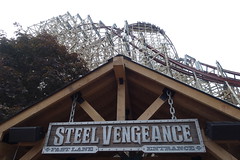 A loose storyline is set up in the queue, in what at first seems to be a clever way to add character and backstory inspired by the implicit personalities of the otherwise under-themed roller coasters of Frontiertown (Maverick is methodical yet unpredictable; Steel Vengeance is mad and furious), yet upon reading the gigantic text blocks7 it quickly descends into “bargain bin paperback melodrama”, written with all the intrigue and eroticism that one would expect from a Cedar Fair publication. Unfortunately I have no photographic reference from the queue, because at the time of my visit all loose items (cell phones and cameras in particular) were required to go in a locker for the entire duration of the 2+ hour wait.8
A loose storyline is set up in the queue, in what at first seems to be a clever way to add character and backstory inspired by the implicit personalities of the otherwise under-themed roller coasters of Frontiertown (Maverick is methodical yet unpredictable; Steel Vengeance is mad and furious), yet upon reading the gigantic text blocks7 it quickly descends into “bargain bin paperback melodrama”, written with all the intrigue and eroticism that one would expect from a Cedar Fair publication. Unfortunately I have no photographic reference from the queue, because at the time of my visit all loose items (cell phones and cameras in particular) were required to go in a locker for the entire duration of the 2+ hour wait.8
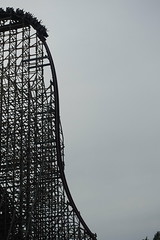 All the little criticisms from outside the ride melt away once we’re staring down that 200 foot, 90° drop. From beginning to end, the ride is gonzo. If you’re the type that enjoys relentlessly paced rides full of extreme forces in every direction, there are few others on the planet that I can think of to match. Certainly none that keep it going as long and consistently as Steel Vengeance does. Its rival next door, Maverick, certainly is a worthy peer, possibly the most worthy on the planet, but even it seems to know how to strategically place pauses and separate elements from one another to prevent peoples’ brains from melting.
All the little criticisms from outside the ride melt away once we’re staring down that 200 foot, 90° drop. From beginning to end, the ride is gonzo. If you’re the type that enjoys relentlessly paced rides full of extreme forces in every direction, there are few others on the planet that I can think of to match. Certainly none that keep it going as long and consistently as Steel Vengeance does. Its rival next door, Maverick, certainly is a worthy peer, possibly the most worthy on the planet, but even it seems to know how to strategically place pauses and separate elements from one another to prevent peoples’ brains from melting.
All of this makes Steel Vengeance quite possibly the greatest of the “Maximalist” coaster designs, which I suspect for many automatically translates into an all-time favorite ranking. Apart from the block brake there’s never a length of track that tries to do anything less than turn it up to eleven. Even the pre-lift taken at 10mph squeezes a couple of dips in before the uphill climb.9 Every element in the layout is in competition with one another to be a contender for the “best part of the ride” title with whatever kinetic energy it has, and the competition is intense.
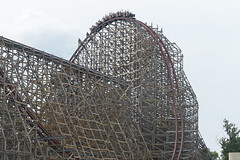 The sequence of big elements in the first half of the layout all make an extremely strong impression, so much so that the 90° 200 foot drop that kicks things off feels the most vanilla of the bunch. There’s a small speed bump at the bottom which I could take or leave; I appreciate the sense of sustained speed but it essentially only serves to jab you in the groin. The first big camelback hill is a quasi-tophat element of the kind usually reserved for launch coasters, but it makes a fine appearance here with strong sustained ejector airtime over the entire crest, minimizing the lateral forces with subtle twists as it careens skyward or towards terra firma.
The sequence of big elements in the first half of the layout all make an extremely strong impression, so much so that the 90° 200 foot drop that kicks things off feels the most vanilla of the bunch. There’s a small speed bump at the bottom which I could take or leave; I appreciate the sense of sustained speed but it essentially only serves to jab you in the groin. The first big camelback hill is a quasi-tophat element of the kind usually reserved for launch coasters, but it makes a fine appearance here with strong sustained ejector airtime over the entire crest, minimizing the lateral forces with subtle twists as it careens skyward or towards terra firma.
The second large hill was the one I was most looking forward to: the outward banked camelback hill. While it looks impossible (or, at the very least, punishing), it actually produces almost no lateral G-forces while maintaining strong, sustained negative G-forces, a concept that had theoretically been proven in the NoLimits fan community since the mid-aughts, yet curiously it took nearly a decade before anyone tried building one in real-life.10 It works exactly as it’s supposed to, effortlessly converting all its lateral force into negative force for a longer moment of ejector air than would normally be possible for a hill that size, and with some amazingly surreal visuals to boot.
to: the outward banked camelback hill. While it looks impossible (or, at the very least, punishing), it actually produces almost no lateral G-forces while maintaining strong, sustained negative G-forces, a concept that had theoretically been proven in the NoLimits fan community since the mid-aughts, yet curiously it took nearly a decade before anyone tried building one in real-life.10 It works exactly as it’s supposed to, effortlessly converting all its lateral force into negative force for a longer moment of ejector air than would normally be possible for a hill that size, and with some amazingly surreal visuals to boot.
There’s a fast double-up that leads to an inclined barrel roll,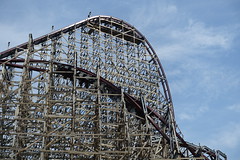 which surprised me with how much I loved this maneuver, possibly even more than the preceding two hills. The rotation starts fast and early, and by the time you crest the top of the hill you’ve already turned back upright, yet the rotation continues without pause into the next highly banked turn, so it’s really almost one-and-a-half rolls… while simultaneously cresting over an airtime hill. That’s a powerful combination for doing some pretty weird stuff to your body.
which surprised me with how much I loved this maneuver, possibly even more than the preceding two hills. The rotation starts fast and early, and by the time you crest the top of the hill you’ve already turned back upright, yet the rotation continues without pause into the next highly banked turn, so it’s really almost one-and-a-half rolls… while simultaneously cresting over an airtime hill. That’s a powerful combination for doing some pretty weird stuff to your body.
The carousel around the lift hill creates an undulating motion that sets up the next “half-stall” inversion nicely, and you get a good twist of rotation with a momentary pause of zero-Gs while looking at the world from an unusual angle. Despite being the most “unique” of the four inversions, I was less taken with this one. It happens very quickly, offering little of the hangtime you get from the top gun stalls on other RMC coasters, and the fast rotation back and forth honestly feels a bit… non-committal?… compared to the satisfaction of the sustained rotation of the previous inversion. In a different context I’m sure I’d love it, it’s just that after the first sequence of elements where each so successfully builds off the success of its predecessor, this one just isn’t quite able to keep amplifying the “wows” to the fever pitch one would expect by this point. (As I said, all the elements are in competition with each other, and with a ride like Steel Vengeance that competition is a bloodsport.)
There’s another quick pop of airtime before it’s up into a hard curve into the block brake. Whether or not there’s any braking seems to depend on the time of day and how fast the train is running. It does seem that the braking system is on an “all or none” binary. Thus the excitement of the following camelback hill and S-curve hop into the support structure depends greatly on the time of day, but as soon as you’ve made it into the superstructure it’s once again an A+ ride no matter what those brakes were doing.
If the first half of the ride is all about individual elements being in competition with one another, the second half is when the elements begin to cooperate with one another. The train dives into the superstructure into an overbanked turn followed by a zero-G roll. I would have expected these to be relatively conservative elements compared to everything that preceded so far, but this was actually the moment on my first ride that most favorably surprised me. The superstructure has such a dense repeating pattern of wooden geometry surrounding you on all sides, that once you start turning past 90 degrees it’s easy to lose your orientation and forget which way is up or down. The overbank is speedy yet graceful, which was something of a relief because the relentless negative and lateral G’s were starting to wear me down, and the transition into
elements begin to cooperate with one another. The train dives into the superstructure into an overbanked turn followed by a zero-G roll. I would have expected these to be relatively conservative elements compared to everything that preceded so far, but this was actually the moment on my first ride that most favorably surprised me. The superstructure has such a dense repeating pattern of wooden geometry surrounding you on all sides, that once you start turning past 90 degrees it’s easy to lose your orientation and forget which way is up or down. The overbank is speedy yet graceful, which was something of a relief because the relentless negative and lateral G’s were starting to wear me down, and the transition into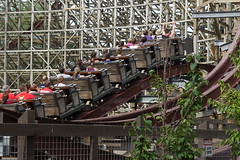 the zero-G roll is natural and fluid. The result is an odd mismatch between visual and physical sensations where I momentarily lost track of which element I was in and whether our train had righted itself yet or was still upside down. This was also one of the few moments of the coaster where I didn’t feel compelled to ride defensively and could take it all in and enjoy it.
the zero-G roll is natural and fluid. The result is an odd mismatch between visual and physical sensations where I momentarily lost track of which element I was in and whether our train had righted itself yet or was still upside down. This was also one of the few moments of the coaster where I didn’t feel compelled to ride defensively and could take it all in and enjoy it.
Exiting the superstructure momentarily are two more sharp airtime hops, the second of which has a vicious little lateral shimmy just after the apex that’s almost too slight to even notice in videos, but was quite jarring when actually riding. It then repeats the overbank and zero-G roll formula again with minor variations as it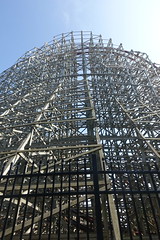 reenters the superstructure, to similarly successful results. The first overbank features an inflection near the crest to become a wave turn (a smaller version of similar elements on Outlaw Run and Lightning Rod), creating a pop of airtime at the top while rotated 90 degrees. Again, buried deep within the superstructure, this element becomes an optical illusion that toys with your sense of the true direction of gravity. This curve hands off naturally to the final inversion, a barrel roll that isn’t quite as disorienting as the previous but is still a good element nonetheless, and a final overbank curve. While the ride is clearly starting to wind down by the end of this sequence, the twisting between left and right combined with the surreal setting inside the wood structure makes this entire sequence possibly the most satisfying of the entire ride. Finally, RMC has devised a set of elements with a sense of rhythm where the whole is equal to more than the sum of its parts.
reenters the superstructure, to similarly successful results. The first overbank features an inflection near the crest to become a wave turn (a smaller version of similar elements on Outlaw Run and Lightning Rod), creating a pop of airtime at the top while rotated 90 degrees. Again, buried deep within the superstructure, this element becomes an optical illusion that toys with your sense of the true direction of gravity. This curve hands off naturally to the final inversion, a barrel roll that isn’t quite as disorienting as the previous but is still a good element nonetheless, and a final overbank curve. While the ride is clearly starting to wind down by the end of this sequence, the twisting between left and right combined with the surreal setting inside the wood structure makes this entire sequence possibly the most satisfying of the entire ride. Finally, RMC has devised a set of elements with a sense of rhythm where the whole is equal to more than the sum of its parts.
The final series of rapid-fire bunny hops seems to be the most controversial part of the layout, and after harboring some mixed feelings over their merits, I’ve mostly come out in favor of them. As I mentioned earlier, I don’t really care much for RMC’s speed bumps, since they’re too sudden to create much of a pleasurable sensation of airtime and mostly serve to jarringly interrupt what would otherwise be a sustained moment of speed. Nevertheless, in this context I think they work, mostly because of the repetition and the fact that there’s nothing else quite like them on any coaster I can recall. Too small to even be classified as “bunny hops”, they basically play the opposite tact of a helix finale (where you end the ride on a singularly strong and sustained “finale” motion), instead opting to accelerate the timing interval between elements to as rapid-fire of a pace as possible before the show’s over. Given the ways in which maximalism defines everything else about this ride, it makes perfect sense as a finale. It helps that the speed bumps themselves are still fairly fun and not too uncomfortable.
pleasurable sensation of airtime and mostly serve to jarringly interrupt what would otherwise be a sustained moment of speed. Nevertheless, in this context I think they work, mostly because of the repetition and the fact that there’s nothing else quite like them on any coaster I can recall. Too small to even be classified as “bunny hops”, they basically play the opposite tact of a helix finale (where you end the ride on a singularly strong and sustained “finale” motion), instead opting to accelerate the timing interval between elements to as rapid-fire of a pace as possible before the show’s over. Given the ways in which maximalism defines everything else about this ride, it makes perfect sense as a finale. It helps that the speed bumps themselves are still fairly fun and not too uncomfortable.
By the time we reached the brakes, it was immediately clear to me that Steel Vengeance was a top-tier ride. The question was just how high up the tiers was I willing to rank it?
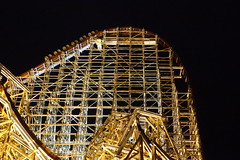 I’m glad I did away with my old ranked lists of coasters a few months before riding Steel Vengeance and replaced it with two categories of “Essential” coasters (of which I target around five but I’m not beholden to that exact number) and “Very Good” coasters. Cedar Point already is home of two of my most essential steel coasters, Magnum and Maverick, and while for a brief second I thought maybe the park would get a third, I had to conclude that I could recognize it as only “Very Good”. It’s a full-sensory overload of a coaster, but it ultimately left me feeling more fatigued than exhilarated. While it has lots of good ideas and does a better job at pacing itself and creating a satisfying ride narrative than most
I’m glad I did away with my old ranked lists of coasters a few months before riding Steel Vengeance and replaced it with two categories of “Essential” coasters (of which I target around five but I’m not beholden to that exact number) and “Very Good” coasters. Cedar Point already is home of two of my most essential steel coasters, Magnum and Maverick, and while for a brief second I thought maybe the park would get a third, I had to conclude that I could recognize it as only “Very Good”. It’s a full-sensory overload of a coaster, but it ultimately left me feeling more fatigued than exhilarated. While it has lots of good ideas and does a better job at pacing itself and creating a satisfying ride narrative than most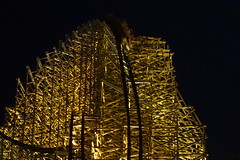 other RMC conversions, it’s still a little too hyperactive and lacks the sense of dramatic pacing and joyous discovery. Essential rides like Magnum or Maverick offer more than one emotional beat. There’s anticipation and suspense, joy, awe, and “Holy Shit”. Steel Vengeance is non-stop “Holy Shit”, and while that’s a great feeling after my first four rides, I’d imagine after forty rides I’d be expecting a little bit more.
other RMC conversions, it’s still a little too hyperactive and lacks the sense of dramatic pacing and joyous discovery. Essential rides like Magnum or Maverick offer more than one emotional beat. There’s anticipation and suspense, joy, awe, and “Holy Shit”. Steel Vengeance is non-stop “Holy Shit”, and while that’s a great feeling after my first four rides, I’d imagine after forty rides I’d be expecting a little bit more.
Nuances aside, my biggest knock against Steel Vengeance is its vehicles. While I’m glad to see coaster manufacturers uniformly move towards greater upper-body freedom in their restraint designs, it’s come at the expense of some of the most restrictive lower-body restraints the industry has ever developed, and the new-generation trains on Steel Vengeance only make the design worse. The form-fitted bucket seats and lap-bars aren’t great for experiencing lateral forces (especially when combined with strong negative G-forces), and the the shin-guards were so restrictive on my legs that I had barely an inch of wiggle room, my feet awkwardly locked in a tippy-toe position that didn’t feel very pleasant on my Achilles tendon. Whenever there was a delay in the station or on the brake run I’d have to find ways to distract my mind from the pinned-in discomfort in my legs, lest I might be on the verge of getting a claustrophobic panic attack. Off the top
restrictive lower-body restraints the industry has ever developed, and the new-generation trains on Steel Vengeance only make the design worse. The form-fitted bucket seats and lap-bars aren’t great for experiencing lateral forces (especially when combined with strong negative G-forces), and the the shin-guards were so restrictive on my legs that I had barely an inch of wiggle room, my feet awkwardly locked in a tippy-toe position that didn’t feel very pleasant on my Achilles tendon. Whenever there was a delay in the station or on the brake run I’d have to find ways to distract my mind from the pinned-in discomfort in my legs, lest I might be on the verge of getting a claustrophobic panic attack. Off the top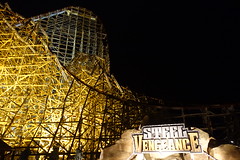 of my head, only the since-removed horse collars on Magic Mountain’s Revolution, the Intamin second-gen multi-looper trains (on rides like Thorpe Park’s Colossus), and the Pinfari portable looping coasters (such as Tornado at M&Ds Scotland’s Theme Park) rank worse in terms of overall degree of comfort and flexibility among coasters I’ve been on.
of my head, only the since-removed horse collars on Magic Mountain’s Revolution, the Intamin second-gen multi-looper trains (on rides like Thorpe Park’s Colossus), and the Pinfari portable looping coasters (such as Tornado at M&Ds Scotland’s Theme Park) rank worse in terms of overall degree of comfort and flexibility among coasters I’ve been on.
This also makes Steel Vengeance, along with the Tornado, one of only two coasters that have ever given me a bruise. After finishing with the park I discovered a large purple mark across my upper left thigh where the lapbar had made contact, which stayed with me for another four to five days afterward. With my legs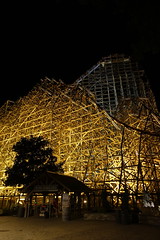 completely confined to prevent getting any leverage, I had no way to brace or shift my weight to cushion against the relentless negative G-forces, and this was evidently the result after just four rides. While it’s always possible I may have to learn a better “riding strategy” (and even so, it wouldn’t to deter me from riding again next time I’m in Sandusky), it should go without saying that the risk of internal bleeding is not a quality I generally accept from my all-time top-rated coasters.
completely confined to prevent getting any leverage, I had no way to brace or shift my weight to cushion against the relentless negative G-forces, and this was evidently the result after just four rides. While it’s always possible I may have to learn a better “riding strategy” (and even so, it wouldn’t to deter me from riding again next time I’m in Sandusky), it should go without saying that the risk of internal bleeding is not a quality I generally accept from my all-time top-rated coasters.
Ultimately I need more than four rides on it to give Steel Vengeance a fair assessment. Yet this ride clearly has some uniquely outstanding quality, if by no other evidence than it’s the only new coaster I’ve experienced in the past six years to motivate me to sit down and write specifically about.11 Perhaps I was under the belief that I had said all I had needed to say on this website, and with my best essays already behind me there would be no point for me to write anything further on the topic ever again.
Steel Vengeance obviously proved me wrong.
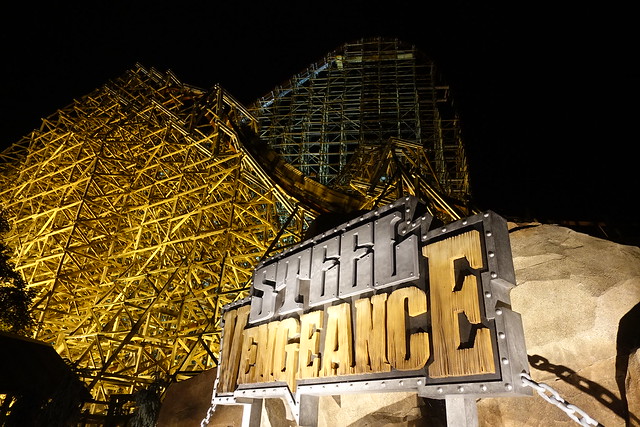
Footnotes & Annotations
[1] Just before his death he finished a second work, Philosophical Investigations, which was regarded as one of the most important philosophical works of the 20th century… and refuted the core argument he made in the Tractatus.
[2] After a cursory glance at the scene, the SBNO structure of Gwazi is already a confirmed candidate that yields some promise for greatness, especially if they’re able to keep the twin-tracked arrangement. The Boss at Six Flags St. Louis seems to offer the next best bet for another stand-out mega RMC conversion, with a massive structure along a more unconventional, sprawling terrain layout. Japan has a couple large wooden structures that could result in something interesting such as Jupiter, Regina, or the already-in-the-works White Cyclone. I’ve heard some fans ask for RMC’ed versions of The Beast or The Voyage, which besides being absolutely the stupidest idea I’ve ever heard in coaster enthusiast-dom that would unquestionably result in worse rides that current management would 100% never greenlight, they’re not even that compelling structures for RMC to work with, being mostly stretched out, low-to-the-ground layouts that the polyurethane wheels would struggle mightily to chug along by the end of the circuit.
[3] CCI does so well that they retain all their designers who might have considered forming their own design companies, and they continue building another 50 wood coasters around the world with many of the same elements until they’re acquired by B&M-Vekoma in 2012 and rolled into their existing prefabricated wood coaster division.
[4] cough*Twisted Cyclone*cough
[5] A poor choice to be sure, but the fact that Mean Streak was the only coaster at Cedar Point that never had any lines had a lot to do with the choice.
[6] Technically the Beast was longer and the Rattler was taller and faster, but occupying the highest matrix position between those categories I think Mean Streak could lay claim to the “largest” until Son of Beast took the title in 2000.
[7] Even in the slow-moving queue it was difficult to finish reading it all in time.
[8] A rental is valid for a strict 2 hours before extra fees apply. As far as I can tell the cellphone locker policy does relatively little to improve safety and mostly just teaches guests that safety policies are arbitrarily punitive and meant to be subverted. Still lots of smuggled phones were glimpsed throughout the queue.
[9] I’m actually not much of a fan of these dips. On some coasters I think they’re fine since they create a playful emotional cue that signals to riders when and how to engage with the ride experience, but on a coaster as grand and intimidating as Steel Vengeance I think it just adds unnecessary clutter to what should be an emotionally focused part of the experience, which is all about the anticipatory dread of the uphill climb.
[10] Outlaw Run and Lightning Rod both gently flirt with the concept with their outside wave turns (which will also feature later in Steel Vengeance’s own layout), and there’s a couple of lateral-heavy outward banked curves out there on other designs, but this was the first one attempted with a steeply pitched curve along a strong, sustained negative G-force crest as a means to actually cancel out the lateral force.
[11] This is also somewhat incredibly the first time I’ve properly discussed RMC on this website.
Great article! I always enjoy reading your posts. I’m curious if you have been to Kings Island since your last post on that park and what your thoughts are on Banshee and Mystic Timbers.
Yes I have!
Banshee I really really like, much more than Diamondback. Might even be my second favorite coaster in the park. Good sequence of standard and non-standard elements, beneficial use of the terrain, and it stays really strong and powerful all the way to the end, except for when it stalls out in the barrel roll which is a great and strange little finale.
Mystic Timbers I think is a great example of maximizing the potential of an otherwise mid-sized, mid-ranked coaster, but it also kind of left me feeling like it wanted to be a much more important coaster that didn’t quite make it. That’s especially true of the shed, where it’s a great concept and execution to plus up what would otherwise be a holding brake zone, but if you think of it as a show finale unto itself it doesn’t quite hold up. The ride layout is uniformly great (it’s some of GCI’s best maneuvering in a wooded terrain setting, how could it not be?) but it’s also very uniform; hard to tell beginning from middle from end. It’s clearly meant to both compliment and counterpoint The Beast, and for me The Beast is still the clear winner in that comparison.
Come back to England and review Icon, The Smiler and Wickerman! 🙂
Great review! I only managed one lap on this monster in 2018, so any opinion I hold of it is pretty tentative as I prefer multiple laps to really get a feel for what’s happening, but I left feeling like it was so focused on doing so much that it missed opportunities to exploit the value of simplicity. I contend that despite being an absolute monster, it did almost nothing to capitalize on just how massive it is save for having a lot of length. It rarely ever felt like it was this massive hypercoaster because there were almost no sustained “grand” elements. I feel like an occasional drawn-out maneuver would have been a nice touch less for a breather than simply for variety. It feels weird to say that a break in the action would actually spice things up, but I genuinely feel that it would have been to Steel Vengeance’s benefit.
“…I feel I can say with some confidence that even if there are some other very good RMC conversions in the future, I’m doubtful they can 100% eclipse the scale and ambition of Steel Vengeance…”
Looks like Iron Gwazi is about to prove you right.
LOL!
Now that you have ridden Iron Gwazi, any thoughts? I couldn’t help but notice it didn’t make it unto your “Very Good” list, while New Texas Giant and ArieFoce One did.
Yeah I really haven’t been keeping up on nearly any reviews, have I? I guess I’ll do it by request now, so here’s some thought on Iron Gwazi.
So I got six rides on Iron Gwazi throughout my visit this fall – three in the morning, two in the afternoon, and one at night (during Howl-O-Scream).
The morning rides I thought it had a decent first half relative to other RMCs (which should have been a given with its hyper-hybrid status; you don’t build a ride that tall to run even with the mid-tier class). But after the outer wave bank over the station it seemed to quickly lose the plot, with some odd meandering bits that didn’t add up to much before the brake run abruptly appeared at least three elements too early. A very uneven ride shifting from upper-tier to lower-tier RMC in my initial opinion.
The afternoon rides I warmed up a little bit to the second half, as much for approaching it with a refreshed frame of mind as for the ride’s own ability to warm itself up. Still, I wasn’t going to move it past other RMCs in my estimation that do a better job of pacing themselves regardless of conditions or expectations.
The night ride, in the front row, alternating between total darkness and crimson red fog, flying through the entire course like a bat out of hell… THAT was a world class experience and probably among my top five individual coasters rides I got that year (and 2023 was an insanely productive year for me).
So I was a bit conflicted on how to rate it overall, but if 1/6 of my experience was truly great under somewhat rare-to-duplicate circumstances with the remaining 5/6 being generally good but conflicted, I kinda still got to rate it by the average with an asterisk that the right conditions can greatly improve it.